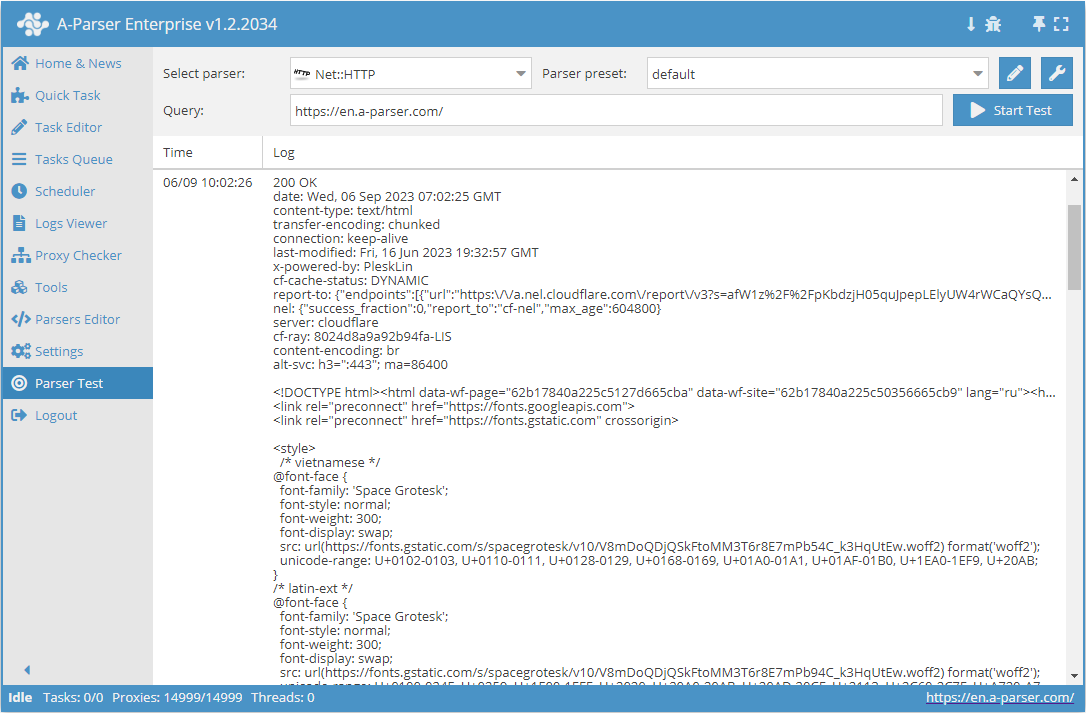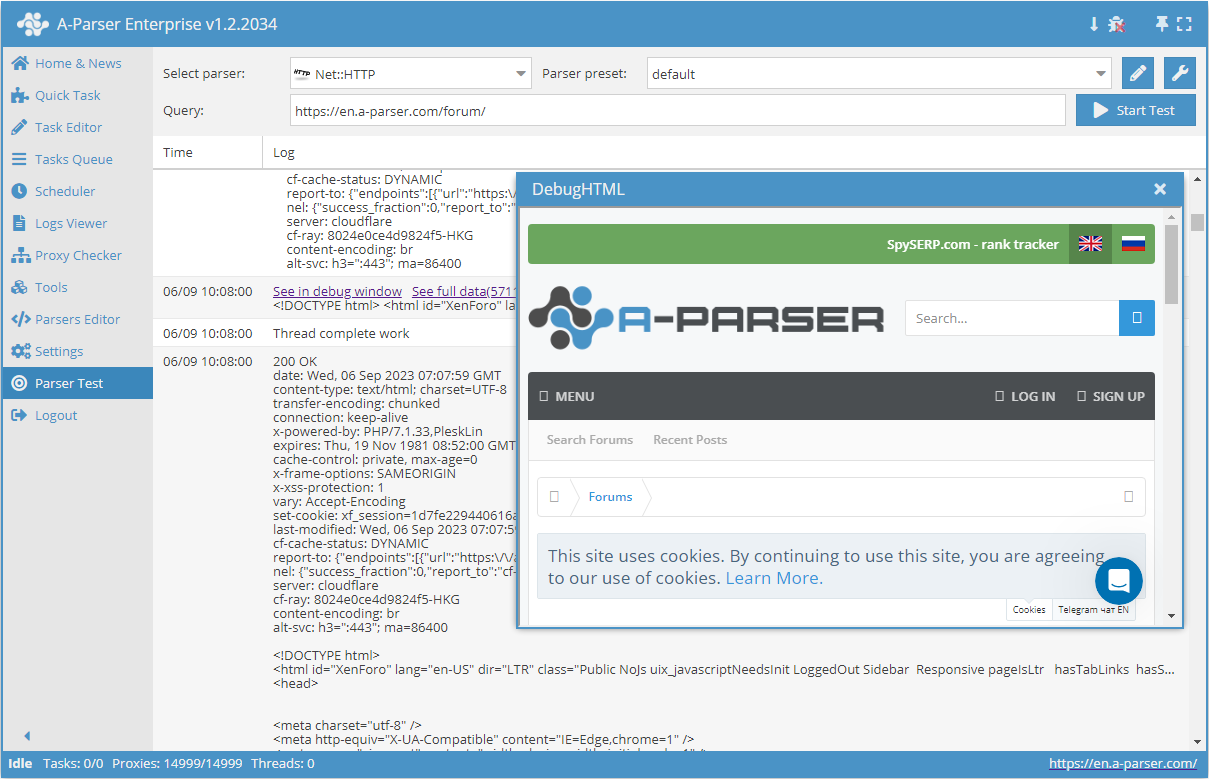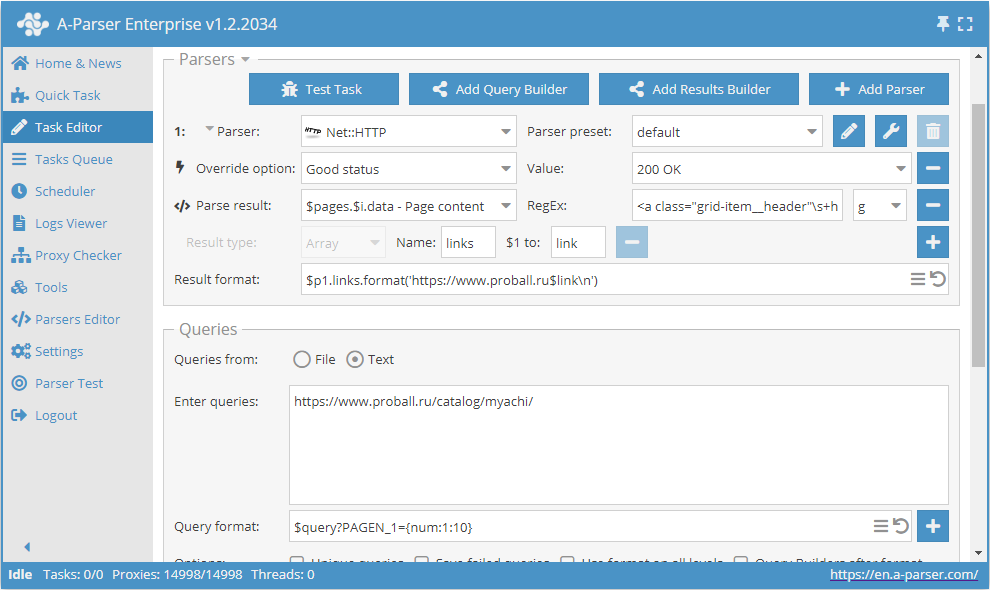Net::HTTP - A universal base scraper with support for multi-page scraping and CloudFlare bypass
Overview

 Net::HTTP – is a universal scraper that allows solving most non-standard tasks. It can be used as a basis for parsing arbitrary content from any websites. It allows downloading the page code by link, supports multi-page scraping (navigation through pages), automatic work with proxies, allows you to perform a check of a successful response by code or by page content.
Net::HTTP – is a universal scraper that allows solving most non-standard tasks. It can be used as a basis for parsing arbitrary content from any websites. It allows downloading the page code by link, supports multi-page scraping (navigation through pages), automatic work with proxies, allows you to perform a check of a successful response by code or by page content.Use cases for the scraper
🔗 REG.RU domain auction
Scraping the auction of expiring domains with the ability to filter
🔗 SSL certificate data
Scraping SSL certificate data of domains from the leaderssl.ru website
🔗 Scraping Booking.com resource
Retrieving search results for apartments and hotels on the website
🔗 Collecting product characteristics
An example of scraping an unknown number of product characteristics
🔗 Scraping the movie database from IMDB
Retrieves data about each movie and records it in the result
🔗 Checking for HTTPS presence
The preset checks for the presence of HTTPS on the site
Collected data

- Content
- Server response code
- Server response description
- Server response headers
- Proxies used during the request
- Array with all collected pages (used when the Use Pages option is active)
Capabilities
- Multi-page scraping (navigation through pages)
- Automatic work with proxies
- Checking for a successful response by code or by page content
- Supports gzip/deflate/brotli compression
- Detection and conversion of site encodings to UTF-8
- CloudFlare protection bypass
- Choice of engine (HTTP or Chrome)
- The Check content option – performs the specified regular expression on the received page. If the expression does not work, the page will be reloaded with another proxy.
- The Use Pages option – allows you to iterate through a specified number of pages with a certain step. The variable
$pagenumcontains the current page number during iteration. - The Check next page option – you need to specify a regular expression that will extract the link to the next page (usually the "Forward" button), if it exists. Transition between pages is carried out within the specified limit (0 - no restrictions).
- The Page as new query option – transition to the next page occurs in a new request. Allows you to remove the limitation on the number of pages for navigation.
Use cases
- Downloading content
- Downloading images
- Checking server response code
- Checking for HTTPS presence
- Checking for redirects
- Outputting the list of redirect URLs
- Getting page size
- Collecting meta tags
- Extracting data from the page source code and/or headers
Requests
As requests, it is necessary to specify links to pages, for example:
http://lenta.ru/
http://a-parser.com/pages/reviews/
Output Results Examples
A-Parser supports flexible formatting of results thanks to the built-in template engine Template Toolkit, which allows it to output results in any form, as well as in structured formats, such as CSV or JSON
Content Output
Result format:
$data
Example of result:
<!DOCTYPE html><html id="XenForo" lang="ru-RU" dir="LTR" class="Public NoJs uix_javascriptNeedsInit LoggedOut Sidebar Responsive pageIsLtr hasTabLinks hasSearch is-sidebarOpen hasRightSidebar is-setWidth navStyle_0 pageStyle_0 hasFlexbox" xmlns:fb="http://www.facebook.com/2008/fbml">
<head>
<!-- Google Tag Manager -->
<!-- End Google Tag Manager -->
<meta charset="utf-8" />
<meta http-equiv="X-UA-Compatible" content="IE=Edge,chrome=1" />
<meta name="viewport" content="width=device-width, initial-scale=1" />
<base href="https://a-parser.com/" />
<title>A-Parser - парсер для профессионалов SEO</title>
<noscript><style>.JsOnly, .jsOnly { display: none !important; }</style></noscript>
<link rel="stylesheet" href="css.php?css=xenforo,form,public,parser_icons&style=9&dir=LTR&d=1612857138" />
<link rel="stylesheet" href="css.php?css=facebook,google,login_bar,moderator_bar,nat_public_css,node_category,node_forum,node_list,notices,panel_scroller,resource_list_mini,sidebar_share_page,thread_list_simple,twitter,uix_extendedFooter&style=9&dir=LTR&d=1612857138" />
<link rel="stylesheet" href="css.php?css=uix,uix_style&style=9&dir=LTR&d=1612857138" />
Server Response Code
Result format:
$code
Example of result:
200
The result format [% response.Redirects.0.Status || code %] allows displaying the status 301, if there are redirects in the request.
Getting Query Data
The variable $response helps to get information about the request and the server response
Result format:
$response.json\n
Example of result:
{
"Time": 3.414,
"connection": "keep-alive",
"Decode": "Decode from utf-8(meta charset)",
"cache-control": "max-age=3600,public",
"last-modified": "Tue, 18 May 2021 12:42:56 GMT",
"transfer-encoding": "chunked",
"date": "Thu, 27 May 2021 14:18:42 GMT",
"Status": 200,
"content-encoding": "gzip",
"Body-Length-Decoded": 1507378,
"Reason": "OK",
"Proxy": "http://51.255.55.144:25302",
"content-type": "text/html",
"Redirects": [],
"server": "nginx",
"Request-Raw": "GET / HTTP/1.1\r\nAccept: text/html,application/xhtml+xml,application/xml;q=0.9,image/webp,image/apng,*/*;q=0.8\r\nAccept-Encoding: gzip, deflate, br\r\nAccept-Language: en-US,en;q=0.9\r\nConnection: keep-alive\r\nHost: a-parser.com\r\nUpgrade-Insecure-Requests: 1\r\nUser-Agent: Mozilla/4.0 (compatible; MSIE 6.0; Windows NT 5.1; SV1)\r\n\r\n",
"URI": "https://a-parser.com/",
"HTTPVersion": "1.1",
"Body-Length": 299312,
"Decode-Mode": "auto-html",
"etag": "W/\"60a3b650-170032\"",
"Decode-Time": 0.003,
"IP": "remote",
"expires": "Thu, 27 May 2021 15:18:42 GMT"
}
Getting Redirects
Request:
https://google.it
Result format:
$response.Redirects.0.URI -> $response.URI
Example of result:
https://google.it/ -> https://www.google.it/
JSON with Redirects
Result format:
$response.Redirects.json
Example of result:
[{"x-powered-by":"PleskLin","connection":"keep-alive","URI":"http://a-parser.com/","location":"https://a-parser.com/","date":"Thu, 18 Feb 2021 09:16:36 GMT","HTTPVersion":"1.1","Status":301,"content-length":"162","Reason":"Moved Permanently","Proxy":"socks5://51.255.55.144:29683","content-type":"text/html","IP":"remote","server":"nginx","Request-Raw":"GET / HTTP/1.1\r\nAccept: text/html,application/xhtml+xml,application/xml;q=0.9,image/webp,image/apng,*/*;q=0.8\r\nAccept-Encoding: gzip, deflate, br\r\nAccept-Language: en-US,en;q=0.9\r\nConnection: keep-alive\r\nHost: a-parser.com\r\nUpgrade-Insecure-Requests: 1\r\nUser-Agent: Mozilla/4.0 (compatible; MSIE 6.0; Windows NT 5.1; SV1)\r\n\r\n"}]
Server Response Status
Result format:
$reason
Example of result:
OK
Server Response Time
Result format:
$response.Time
Example of result:
1.457
Getting Page Size
As an example, the size is presented in three different options.
Result format:
[% "data-length: " _ data.length _ "\n";
"Body-Length: " _ response.${'Body-Length'} _ "\n";
"Body-Length-Decoded: " _ response.${'Body-Length-Decoded'} _ "\n" %]
Example of result:
data-length: 70257
Body-Length: 23167
Body-Length-Decoded: 75868
Results Processing
A-Parser allows processing results directly during scraping, in this section we have provided the most popular cases for the scraper Net::HTTP
Outputting H1-H6 Headers
Add a regex (option Use regex) <(h\d)>(.+?)<\/\1>, in the "Apply to" field select $pages.$i.data - Page content, in the field opposite the regex select modifiers sg. As the result type, an array will be automatically selected. In the "Name" field, specify headers, in "$1 to" specify tag, click the plus sign next to it and in "$2 to" specify content. In the Result Format use $p1.headers.format('$content\n').
Download example
How to import an example into A-Parser
eJx9VE1v2zAM/SsFkcMGBEFy2MW3NFiKDVnTNekpyEGNaUOLLGmSnDUw/N9H+ktO
N/Rmko+PfCTlCoLwZ//k0GPwkBwqsM03JLD7miQPxuQK7zZSn/3di5a/S4QpWOE8
OoYfRigKpJiJUgWYVhCuFonEXNA5mXJQpmRbZ96uDoOT6Ml3Eapk2GI+n0P9QZrI
8WRKHWLO4gO44n4tOk4bZcxHKWUvhuRyy8kBSJMlByfDcdoh9i3cU8c6h977oMyr
UJAEV2J9PPYsfm1cIXh4E7uYdZMcgjtxwb2hYCZVrOzXZD2KgqtMUhGQo7OsIfr0
eRbemEGkqQzSaKHaCjz7WLVbTALaEJY+ebprZwpyBWwI2HntuzvApLGjyp9tDiSZ
UB6n4KnVtaBG0vcRGdCJYNzWcj/kr8DopVIbvKCKsIb/vpQqpUNZZpT0rUv8P2T7
D0c9yBuXokX/cdTDwNJY99sfMSs1G5OT8vS1WWYhA9l+1VxPAnNynhHtMLNHnllh
HA5lOuauOr0Ni5qvKq5saaPrRsbNWm6dJ6MzmW+7S+2Rpd7TA9zqlSmsQtalS6Vo
LR6f43ksfbcGNmKD75NXTQmW3r9DCMYo/33XtmqdpPP7wg0WNMlx1Y7yJJR6ed6M
IxBPqjknz7QnutPc0AWRivo4/BGG/0g1/i8kVU1r+eWfWhBrYAj5aBieZs6P+S/t
6pW4
Collecting Meta Tags
Add a regex (option Use regex) (<meta[^>]+>), in the "Apply to" field select $pages.$i.data - Page content, in the field opposite the regex select modifier g. As the result type, an array will be automatically selected. In the "Name" field, specify meta, in "$1 to" specify item. In the Result Format use $p1.meta.format('$item\n').
Download example
How to import an example into A-Parser
eJxtVO9v2jAQ/V8spBatg/XDvkRTJYqEtokRRtNPNJMscsk8/Gu2Q0FR/vfeJSGB
bp/ie37v3Z3PTsUC93u/duAheBZtK2abNYtYBjkvZWB3zHLnwdH2lq0gRNHXJFkj
3jMqFk4WULMrfTBqA74VunYRbdGiAE8SHjhLaaeAIwpuvygIfPvrIf3wMGYdnrRm
Re/QAdw5fkKw+a64IozkPY9KZCKAYmmdpj26ME5xamlk7yckmOQNcnszIvLLi74Z
Dx5P/ACJQXYuJAzwAqMu5wi7ANo9+4wn4Uj98iwTQRjNZZuS6hnKeNbib0l6bZCL
SyfAL5xRCAVoDAg8ncvdslET03mVjfZnq2FRzqWHO+ax1AXHQrL3O9iX48G42FI9
iFfM6JmUSziAHGiN/2MpZIbzneUo+tYJ/0+J//Go+/YuUx3AvTqsoXdposf4x6DK
zNIU58OQQomAsZ+bUtOkPiG4B7D9ma2IpoyDPk3n3GXHK2xBZ8gcRjazA3TVxtVY
rsGd0bkoYmzAiQzOzFIn+E5iPTfKSqC+dCkljsXDZrgeM9+NgYKhwPfieZPi6oUF
Y6T//tSWap3A6/eZClR4kpdZO8sdl/J5s7zcYcOVwuB3CNZH0yn/2L7dyc6o6avY
i6nQGRynjDwCFAZvF3ZYp/0j738F1cVTj6oaJ/bHr1sOtUcMxPCcPI6DRff1GzD1
gDE=
Pagination Examples
Using Use pages
Use pages. This feature allows you to navigate through pagination by specifying a known number of pages in advance.
For example, let's take one of the categories on the product catalog website https://www.proball.ru/catalog/myachi/. At the top and bottom, we see the pagination panel. When clicking on the page number icons, you can see in the browser's address bar how the parameter with the page number is passed at the end of the request:
https://www.proball.ru/catalog/myachi/?PAGEN_1=1
Use pages is a kind of counter that actually substitutes the numbers in order into the variable $pagenum, increasing them by the value we specify

As seen in the screenshot, the scraper's request format uses the variable $pagenum where needed.
The Use pages function will iterate and substitute all the values into the request, effectively we will be getting links for the request
https://www.proball.ru/catalog/myachi/?PAGEN_1=$pagenum
where instead of the variable $pagenum, the page number will be substituted, starting from 1 to 4 with a step of 1.
Thus, it is a way to navigate through the pages of the desired range. This is the limitation of this method - you need to know in advance the number of pages in the pagination. Obviously, when parsing several categories simultaneously, the number of pages will be different everywhere, and as a solution, we can simply specify a larger number of presumed pages. But this is not quite correct, so there is a more optimal solution, which will be discussed further
Download example
eJx1VNtu2kAQ/ZVqhJSgUAhV+2I1jSgqvSgCmtAnjKKtPTZu1rubvXAR8r931jY2
pOmTvWfPXM7M7BzAMvNk5hoNWgPB8gCq/IcAnME5SxF6oJg2qP31EqZog+DbYjEn
PMaEOW6hdwC7V0g2coNaZ7E3ymI6p1LGY1meN4w7oizfXV+vitYicsbK/B5N6Qh0
9RMsKWiKxgdhlsHK36S4I4OP7E3EmTE3IaQU6m1mMX98XCOLUYcQhuZqrTGh28v+
1W03hE9Q2y6qgGkTpQaY1mxPYPmdstxjPBNPpiF65SUEp5lLZTMpzFFqXS7TSoWh
9xrHmecxDsGhEvVgUdW3/hxJJ3y930NR/L+Szw71PpE6Z/YkQqeEb+ejr1+mj8Ob
jvcnXA7FatUkP6mMiKyG/VJYv/JzebG2VplgMNhut32l5W/GeV+7jieFobjothV4
YBtcSHKSZBxbeEKnumQdahT626P3bj8ym7MKVJn4arbZ/RLZcylFSOJ6ORmaiZY5
QRZ3tgb3RxXLWrMfCVfa/qxsIEgYN9gDQ6lOGCUSv7yhUdHMSj2rO0cNkWLE+R1u
kLe00v9nl3GaKDNKyOh7bfg6ZfaPj6KRdxqKOrrVlENLiuWdTI/anxBVU42pR3Kp
sXFQR6790otVKPxgtM0YqRY6S/Cs4OdgJEWSpbN62I5MJxa0FmZiLHPF0WcsHOc9
P+P3beNHpi6wP7QJvjQelyEorWZdgJWSmx8PVapKZzRYH5rmE/r6XA4iWgVcpoN8
z6J1NiBbQjCVNA1+c5XjQi9Hl/J6gDvFRIxUEasdFqti1ayyZuEdThZacKAHCH/M
vOJ4VZ5BGJXHUBcgGBZ/AXULzRU=
Using Сheck next page
Сheck next page is another function that allows you to organize navigation through pagination. Its distinctive feature is that to move to the next page, you need to use a regular expression that will return the link to the next page. This is a more convenient and most commonly used method. However, it cannot be applied to https://www.proball.ru/catalog/myachi/ because there are no links to the next pages in the code. The links there are generated by a script. Therefore, let's take the website http://www.imdb.com/search/name?gender=female as an example. Here, there is pagination at both the beginning and the end of the list. By looking at and analyzing the source code, you can see the presence of a link that allows you to move to the next page:

- in the Next page RegEx field, write the regular expression
- in the Limit field, specify the number of pages you want to navigate through

In the example, 4 is indicated. By setting a limit, we determine how many pages the scraper should navigate through. In our case, 5 pages will be navigated because the count starts from 0. If you set the limit to 0, the scraper will work until it has navigated through all the pages, regardless of their number. This is very convenient to use when you need to scrape all results from all pages
Download example
eJx1VGFT2kAQ/SuZG2aUggGq4DSijnXG2qpAlY4fCM6cZANXL7n07iJYhv/e3RAS
sO0XuH3ZvX1vd2+XzHLzYgYaDFjDvNGSJdmZeWwyg8lLDxZ2wKfA6izh2oAmpxHr
gfW86+FwgHgAIU+lZfUls28JYKR6Ba1FQEEiQHuqVHCpMvuVyxRdRh+bzfHq/xEp
ZjrAtLEtY9id+i2k5I2223T2H0UcqLlxekOn47ZOHLQ7RyfOonNUdS6SRMIjPN8I
22gfHruHHWf/5np4d1t3pHgB5wsKU1XncqZVBI32J7fpHjaPW26r1XYeeMi1yMPY
FsVJaqyK7sFkWpleH7wR1mUKhurALWdj+jKFBQZ0TcJjZyK5Mac+k8JY1CQsRAdI
HRZuzWdnvm8+7Lu18yodur7foBhCa10+ejob19Yeo6fueMuJn7E8zXDNbVoQygGu
NX9DMPvv8YgwSm0KR+oji9PoGZGYHHbakVihYrPpxvtJ2DSky52ZhhDVrTUwIv5O
MFXnIMZYh34y02fELAgEJeGSecvdDLciEjSAR2y1Go8LwldKR5zwStJyMzFumEH7
exUS4lRIh+/He9VS5QN/haHCoFBIKOErtPKyVLBvQF83t1Vdu7A7DNeZqWIlmx+x
+JUVIVboi0ctwFzhQCFkIbuAwLcN6xGrZDZNSJrFfl/HMC/k0kCdGaR6xZFI8P4L
itXcKt3P24IFU/GFlLfwCrJ0y+7/nAoZ4DO9CDHoax74b5f+X3esCnnbqfBtzjVy
KJ0CdaumG+0vAElRjR4hkdJQXJBnzu/FTZNATENVNgOfawHtENwp+C44UXEopv18
bWw803iI66wfX6oINwAxjlMp67RO7svGX5i8wGSUBN8HX2YpkFax4JhVSppvD2uq
iRY4WO2i+YjOrE28RmM+n7siCp7diYoaBriezBo0m+e40FDCaQgRz6ZxgqM3VTgU
tHizqaHhMZQKFrgJAsCyWJ3CarwaFxu42NbLrT3sLVfYmJ9msPYhaeSBGNbIYCuY
11r9ASIaBUM=
As mentioned above, there is a possibility to dynamically limit the number of pages in Use pages. To do this, you need to use Use pages and Сheck next page together. Let's supplement the example that was considered when describing Use pages and add the Сheck next page function to it:

These two functions work together in the following way: Use pages provides navigation through the pages, and Check next page checks whether the next page exists. As soon as Check next page does not find the next page, parsing of that category will be stopped, without waiting for the passage through the entire number specified in Use pages. By combining these functions, we add efficiency to the scraper's operation, saving time and resources
Download example
eJx1VNtuGjEQ/ZXKQkqiEC6V+rJqGtGo9KIIaEKfWBS5u7OLi9d2bC8EIf69M3uF
XJ52fTyXM2fGs2eeu7WbWXDgHQsWe2aKfxaw3MGMp8C6zHDrwNL1gk3AB8GP+XyG
eAwJz6Vn3T3zOwPoozdgrYjJScR4TrWOb3Vx3nCZo8ni42CwPLQeUe68zu7BFYGY
LX+CBSZNwVES7jlb0k0Kz+jwmX+IJHfuOmQpproSHrLHxxXwGGzIwtBdriwkeHve
u7y5CNkXVvnOy4Rpk6UCuLV8h2DxnfCMMCnU2jWGVHkBsWPm2nihlatLreRybals
SFHjWJAdlyzYl0U9eDDVLZ0jnSvSezgYsMPhfS2fcrC7RNuM+6McnQK+mY2+f5s8
Dq87FFHlGXufaLSCaD2BZ191t45EQl8pxK8oxjVpGV+G7FUNJ/53IhNEnqgvl41g
45Im0jPDXiFmr2R+frby3rig399utz1j9V8uZc/mHTIKQ3V20ar+wDcw1xgkERJa
eIynqk0d5Ax0W0e/6EVuc8K4ZEIdbNn9UeKpKFlptCUBBbix1RlCHgurwF1dxaJS
mcYwL3x/lz4sSLh00GUOqY45Eolf3uB4Wu61nVZNQAG1Gkl5BxuQrVkR/2suJE6x
GyXo9LNyfNtk+irGoSnvOBXO0NYih9Yo1nc6rWtfA5hGjQkhmbbQBKgyV3FxSxhQ
NEJtM0amhU4Ingh+CkZaJSKdVuNdW+Zqjqtoqm51ZiQQY5VL2aV3dd82fuQqgenQ
EnzpfFukoKGuVxTzWkv366GkaqzAwfrUNB/Rt+eyH+GrkDrtZzserUQffRGBVOM0
0LYsxgWfmC3K6zJ4NlzFgIoMD8vDstmdzYbdH23QYI/vnf1zs9KGSiILxFAbhy2g
KP8Byg3yDQ==
Use of substitution macros
Substitution macros allow for the sequential substitution of values from a specified range

This preset will work as follows. By specifying in the query format a template:
$query?PAGEN_1={num:1:10}
we add the substitution of values from 1 to 10 (the range can be any) into the query itself. Thus, we get queries that ensure going through the necessary number of pages, of the type:
https://www.proball.ru/catalog/myachi/?PAGEN_1=1
https://www.proball.ru/catalog/myachi/?PAGEN_1=2
...
https://www.proball.ru/catalog/myachi/?PAGEN_1=10
Using substitution macros for pagination is similar to the Use pages function and has the same limitations, that is, you need to specify a specific range of values. The advantage of this method can be considered the fact that through substitution macros you can substitute different values, both numerical and textual, for example, words or expressions. Thus, we can more flexibly insert the necessary parts into queries or form the queries themselves from parts that will be placed in different files if the task requires it
Download example
eJxtVFtP2zAU/iuTVQkQXUsn7SUaQx2iu4i1HXRPTYW85CT1cGzPx+lFUf47x26a
AOMp8Xcu3+dzccUcx0ecW0BwyKJlxUz4ZxH7yROr8WbH+sxwi2C9fcmm4KLo22Ix
JzyFjJfSsX7F3N4ABekNWCtSIKNI6ZxrnV7rcN5wWZLL8sPFxaruIpISnS7uAEMi
Zg8/0ZJIc0BPwh1nK2/JYUcBn/i7RHLEy5jlRPVeOCgeHtbAU7Axi2M8X1vIyHo6
OL86i9ln1sQuDoR5y9IA3Fq+JzB8p7zwmBTqEVtHf/MAsVW9WrXoRNuC+1L1zGgQ
IgZZgE5P1s4ZjIbD7XY7MFb/4VIObNnzTnGsTs661Pd8AwtNSTIhoYMndGq09KgC
4K3H7GeDBDdecJoKJ7Ti8qDEy+zU/Vbiny84U5p86dcKwInVBUEOdq4B98dbLFkv
nK/m468304fRZaXKIhpFo4val78M6X4d0rAo4xKhz5DUTzhpS19bqC2WO21nxksk
vGJajaW8hQ3Izi1QfimFpO7hOKOg703g2y6z/3LU7Y2fU9Ecbi1p6JxSfavzYzke
AUxboKlHCm2hTdAwN3lpPQwoP85df8amg14IfNGDl2CiVSbyWbMiR89SLWgHZ+pa
F0aCV6xKKangCHfdLIyxKbA/dAJfB18HCpLVriZzWkv8cX+QaqygWfvYzgOhb4/q
MKG1kzofFnuerMWQYgmBXNt9eCbCBPlBQs8BO8NVClQPZ0uoaUvaR6N9W6pnT0dU
1dSRvzg/+Pg7eQ/CqDhIPWDRqH4C36ybyg==
Using Page as query
To reduce memory consumption, logic can be defined using the Page as query option. When activated, the Check next page and Use pages functions will substitute each subsequent page into queries as a separate independent query, thereby not accumulating their content in memory. Page as query also allows you to define whether to increase the level of the query Increase (similar to the operation of the tools.query.add tool), or not Keep

Download example
eJx1VNty2jAQ/RWPJg/QEts0gUydpBnCDE0bAiQhkwfgQbHXoCJbriQDKcO/dyXM
tc0LeFd7OXv2siSaqqnqSVCgFQkGS5LZbxKQHh1DQ3Vg/piDfCcVklGpQBqrAemA
DoK7fr+H+ghimnNNKkui3zNAVzEDKVkE+MgilMdCRE1h5RnlOZoMvvj+aPWxR46Z
ThFAqnc+5EH8YZxTr+b6TumVpZGYK6fTd+pu9dJBuX5+6Szq52WnkWUcXuHtnmmv
dnbhntWd0v1d/6FdcTibgvMdwqkoO82JFAl4ta+u7575F1W3Wq05zzSmkhVuZB9i
pplI1QZhOMEgHVhow9MeyCvqTCTE10NScj/flIdkOFSfQ06VQhVnSmNhGbqcpujr
mB8rDgnGoFHETBLKSbA8zNBmCTNd8cnqY0zZccsKUFrmcBx9CpBZszbMADX+ajUa
VQh2H3upWkIm1OQ7yaquZpqbEou3ZzqDvsC3mO2rWyh1aGJgnURUg3l1YxunVHb1
Qh8UuE5ghmmX9CVlvy2HqUBb/JQMVAt7hCoNNoBRvm/ADciJlQmGyK3v49qHBDHl
CktWCLVFEUh0/MKwD1QL2S0YREZE2uDcsrEzs/Fvc8YjnPxGjE4/Csf/m3T/ibHa
lrefCsd9LhHDNoqVbrsPO69ItMUYK4/esG5u2o+yaoo8Xc9BxbZwy1nHcJYICds0
ReQiO+54BqmZkl3LcE+2qoMyDtqyp1wSJXIZmgX2ESHV1HBfDKOEMSxscPOPm2Dn
5lvJ/XRTvhoOvbW4MeivnczsamF6uZ6y0QoDhiKN2bhb3IQNmjzt47Hqpk2R4Hob
7tKc84q5FU+7EWyootVG2JFw7Ny0KQy9m+uFMARXP5/XdGSSIaqaAZtgt/azFiFD
yvnLU3v/hezGFoWJ1lngefP53GVJ9OaGIvEUUBlOvBT35AavG9J6HUNC7R6FuDRj
geOM5RoWinu7Pc7LvasbLPEMkF+qt7YxtRoL1CFpCvtPgurqL0u6AK8=